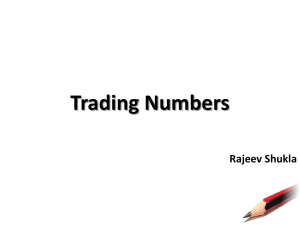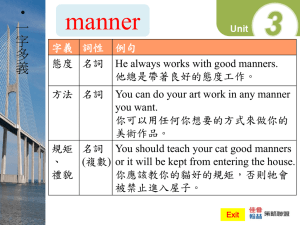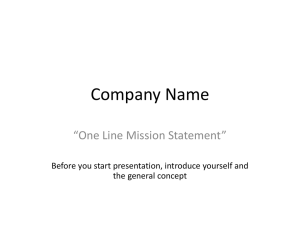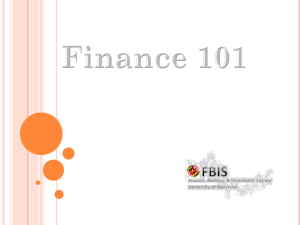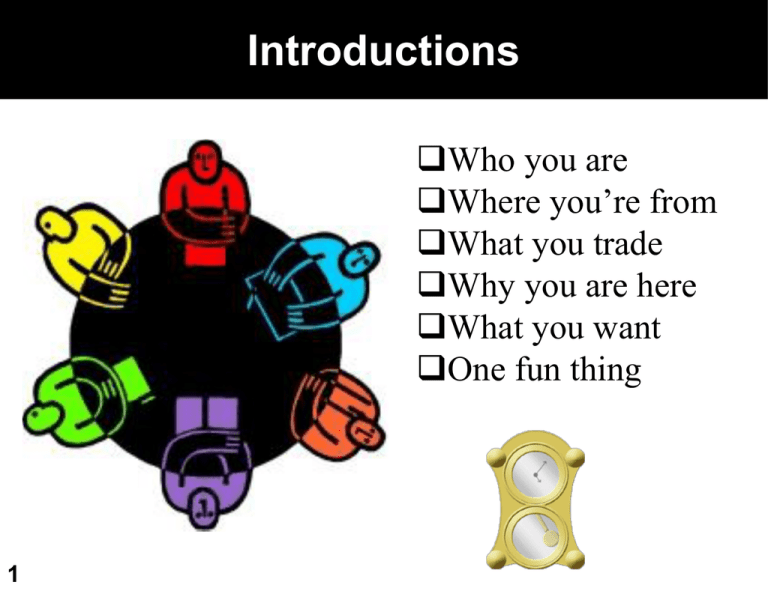
Introductions
Who you are
Where you’re from
What you trade
Why you are here
What you want
One fun thing
1
Finding Your Sweetspot
Self
Market
Stay aligned
System
Self
Market
Get aligned
System
2
Alignment in Action
Self
Market
Results
System
Passion
3
Purpose
Values
Beliefs
Actions
identity
feelings
thoughts
behavior
Trading body of knowledge
Long term investing Swing trading
Intraday trading
•
•
•
•
•
•
•
•
Blended Monthly Rebalancing
Monthly rebalancing
Quarterly rebalancing
Annual rebalancing
•
•
•
•
•
•
•
Channeling
Overreaction
Triple screen
551w
Washout
MaxPain Range Compression
Autoframing
Core & turbo
Frog (3)
RFA
RLCO
SQC
Core & turbo
Techniques & concepts
•
•
•
•
•
•
•
•
•
•
4
Technical analysis
Statistics
Market classification
Position sizing
Trade framing
Core & Turbo
Green, Yellow, Red zones
Stalking and re-entry
Rangestat, slope stat, volstat
SQN and TQN
Systems
Strategies
Techniques
Tips
Material framework
Market
Core
Techniques
&
Tips
Swing
Day
Self
(Psychology, learning style, objectives, skills, risk)
5
Growing the trade
System A
Monthly RB
%
2-10 days
System B
Overreaction
Channeling
Triple screen
Washout
5DD
Max Pain
6
%
System B
Can be a screen
or set-up for
System A !
7
Beliefs about Self
8
Bias
Self-attribution
Overconfidence,
Optimism bias
Confirmation bias
Knowledge illusion
Illusion of
control
Hindsight bias
Illusion
of
Validity
Illusory trends & patterns
Illusory correlation
Sample size
Biased 2d hand
knowledge
10
Representativeness heuristic bias
The inside of my head is a busy place
CEO
Trading
Chief
of
Staff
Cust
Svc
R&D
Prototype
Accting
Benchmark
Staff Call
Production
System System System System System System
A
B1
B2
B3
B4
B4
11
13
Systems Beliefs
14
The Trading System & Plan
Trading System
Executive summary
Business description
Industry overview
Competition
Self Knowledge
Trading Strategy
Beliefs, alliances, coaching
Trading edges
Financial Info
Contingency planning
15
Trading Systems
Market filter
Setup conditions
Entry signal
Protective Stop
Re-entry strategy
Exit strategy
Position sizing algorithm
Beliefs about Systems
A group of components organized to seek a goal in an environment
Environment
Input
•
•
•
•
•
•
•
•
•
•
•
16
Process
Purpose (Objectives)
Whole > Sum of parts
Input-Process-Output
Interactive, Integrative, Iterative
Feedback loops and learning: Relationships
Reinforcing and counterbalancing
Boundaries and durations: Scope
Non-linear, dynamic relationships
Modeling and describing is learning
Hard, Soft, Evolutionary systems
The Map is not the territory, but it can help
Output
Objectives
Be careful what you ask for
Beat the market
Highest return within risk tolerance
Achieve required return at the lowest risk
Unit of return vs unit of risk
Longevity vs shortest time to achieve goal
Be small when wrong, large when right
Feel professional (BE PROFESSIONAL)
17
Monthly review questions
•What worked for my trading this past month? What did not work?
•What do the metrics tell me - in what instruments did I make money? In
which did I lose? Is there a pattern?
•Did I keep to my exercise and meditation schedules?
•Was there a correlation between my trading and how I felt for that day?
•Did I monitor the Ebb & Flow position sizing or did I persist with too large
or too small a size even after market conditions changed?
•What were my greatest challenges/lessons?
•Of what am I most proud? What do I most regret?
•What attitudes and actions will I take with me into the new month? What
lessons have I learned this month?
•What limiting beliefs did I shift? What negative emotions did I shift?
•How did I grow, improve, and expand myself?
18
Decision making systems
19
Oh! The Choices you’ll make!
Time Frames
Risks
Objectives
Trading systems
Trading strategies
Trading vehicles
Risk management
20
Market Beliefs
21
What’s the nature of the market?
Description
Dynamic?
Process
Strategy
Process
Value
• Different situations need different responses,
strategies, approaches
• Boundaries, indicators, volatility?
• What about the market?
Closed, linear
Closed, linear
Static
Static
Rational
Instinct
Engineering
Training
Analysis
Analysis
Control
Speed, precision
Simple
22
Complicated
(Closed), network Open, (network)
Dynamic
Dynamic
Morphing
Systems
Metaphorical
Adaptive
Balance
Modeling
Sense-making
Learning
Complex
Chaotic
Probabilistic
Uncertain
Statistical
Analytical
Calibration
Discipline
Random
Performance Math
23
25%
Stock
25%
Sector
50%
Market
Market Classification
Bull
Bear
Volatile
Quiet
Bull
Bear
Volatile
Quiet
Bull
Sideways
Bear
Volatile
Normal
1/6
2/3
Quiet
Bull
Sideways
Bear
24
1/6
Market classification strategy
Notes:
• SPY = mkt
• 13 years, daily data
• Bull vs Sideways vs Bear
• Volatile vs Normal vs Quiet
• Examine each axis
• Combine into 3x3 matrix
• Examine slope of 50d MA too
• Very interesting results
Average of %gain
mkttype
Total
Bear
Bull
Sideways
Grand Total
Average of %gain
Ctype
Total
11
-0.119
Bear
12
-0.135
Bear
13
-0.145
Bear
21
0.067 Sideways
22
-0.031 Sideways
23
-0.073 Sideways
31
0.101
Bull
32
0.107
Bull
33
0.144
Bull
Grand Total
0.039
SPY
Bull
Sideways
Bear
25
-0.136
0.111
-0.025
0.039
Average of %gain
Vtype
Total
1
quiet
normal
2
volatile 3
Grand Total
Volatile
0.144
-0.073
-0.145
Normal
0.107
-0.031
-0.135
0.070
0.036
0.012
0.039
Quiet
Normal
Volatile
Quiet
Normal
Volatile
Quiet
Normal
Volatile
Quiet
0.101
0.067
-0.119
Market condition
•Volatile
•Bull
•Sideways
•Bear
26
•Normal
•Quiet
Market condition
•Volatile
•Normal
•ETF2
•Bull
•ETF C
•ETF O
•5DD & 5DDC
•WO & WOC
•Triple Screen
•551w screen
•5DD & 5DDC
•Sideways
•WO & WOC
•551w screen
•5DD & 5DDC & 5DDF
•WO & WOC & WO Failure
•Bear
27
•ETF O
•Triple Screen
•Quiet
Mental Models
28
Sector Analysis
The Morningstar Cube
Value
Large
Medium
Small
29
Blend
Growth
Efficiency of Hierarchy
Top-Down Approach
Mkt
Major Indices
Equity Mkt
Dow S&P NAS
Sectors
Companies
V B G
L
M
S
"Morningstar Cube"
30
Efficiency of Hierarchy
Top-Down Approach
Equity Mkt
Major Indices
Mkt
Dow S&P NAS
Sectors
Investor
Companies
V B G
L
M
S
"Morningstar Cube"
31
Management Lens/Filter
(provided by fund
managers)
World Market Model
Value Blend
Growth
Large
DIA
SPY
QQQ
Mid
IJJ
MDY
IJK
Small
IJS
IJR
IJT
Liquid US Index ETFs:
Can be shorted on a downtick
32
33
Stormy Weather
•Results
•Losing Streaks
•Experts
•Advertising
•Media
•Self-doubt
•Emotions
•Success
•Guilt
34
Equities
Beliefs
Real
Estate
Business
Statistics
35
Traffic lighting with statistics
+1 St Dev
Average
-1 StDev
Adaptive
Time period matters
Current state
Changing state
Time series
36
Extremes
1/6
worst
37
2/3
normal
1/6
best
Getting on the bandwagon
1
2
3
4
5
Innovators
Early adopters
Early mass adopters
2
Late mass adopters
1
“Grumpy old men”
5
4
3
100%
50%
0%
38
Systems
39
Systems and timeframes
Frequency
Annual
Quarterly
Monthly
Weekly
Strategy
1
Annual passive
1
2
3
4
Quarterly momentum
1 2 3 4 5 6 7 8 9 10 11 12 Monthly momentum
x x x x x x x x x x x x x x x x x x x x x x x x x x x x x x x x x x x x x x x x x x x x x x x x ETF2
Channelling
Overreaction
Triple Screen
5DD
Washout
Opportunity &
551w
Patterns
RFA
30-60 quality
MaxPain
Modified French Mo
Index RS
Hedged index pairs
40
Decision timing
Example of Green & Yellow Zone
Standard frame
Profit target for the swing trade
I want to be long in the
swing trade position
I can try to front run a green zone
trade if I can see to the one
inside yesterdays range
Green zone
Mechanical entry for the swing trade
Yellow zone
Initial stop for the swing trade
I am out of the swing trade
or I am going short,
because it’s failing
Red zone
When the swing trade pattern fired
41
Green zone & Yellow zone trading
Green Zone Trading:
mechanical trading once Price moves above yesterday’s range
•Use scans & systems to find high probability/high payoff swing trade
candidates
•Any of the Tortoise swing trade systems, patterns, preferences
•Frame the trades that meet 2:1 reward:risk ratios on a re-test of the
10day High
•Enter the trades when price > yesterday’s high +.05
•Initial risk: .05 below yesterday’s low (or 1x ATR if you prefer)
•Once in the trade, use a trailing stop of the initial risk or adjust to .05
below yesterday’s low
Think of the Green Zone as the Core position with
overnight/Swing trade levels of risk
42
Green zone & Yellow zone trading
Yellow Zone Trading:
intraday opportunity trading on a mechanical trade, with tactical
momentum
•Start with any Green Zone trade frame that gives 2:1
•Look for opportunities when you can see 2:1 reward:risk, using the
mechanical entry as your profit target
•Tighten up your stop and prepare to take profits if it stalls near the
mechanical entry
•Consider adding another position at the mechanical entry, or simply
accept the current trade as your mechanical Green Zone trade, but
with an improved entry, and let it become your swing trade
•If you have a successful Yellow Zone trade AND a Green Zone
trade, take the Yellow Zone trade off before the close, so you only
carry the swing trade risk overnight, then seek to get back in the
following day with another Yellow Zone trade
Think of the Yellow Zone as the “Turbo” position with intraday
43 trade levels of risk
Green zone & Yellow zone trading
How to think about trading the “Gap fail”
Any
swing
pattern
can get
us here
44
ETF 2
45
“I got 3% return,
is that any good?”
Indexing
comparing a range of performance
comparing apples and oranges
"normalizes" data, helps trendspotting
15
13
11
6
3
2
1
-3
-4
-5
47
8
5
3
2
1
0
-4
-6
-8
-12
(x-min)
100 *
(max-min)
100*
3- (-5)
15- (-5)
= 40
100* 3- (-12) = 75
8- (-12)
ETF 2.0 summary
Top Down analysis
Market Condition
ETFs
Regions
Calculations
Strength
Consistency
Quality
Asset allocation
Goals
Consistency
Discipline
Routine
Simplicity
48
Reports
Benchmarking
ETF "stars"
Regions
ETF swing trading
ETF 2.0
Average
=
Strength +
Consistency +
Quality
Strength: calculate RS (blended 3 & 6 month performance)
0-100 STR
Consistency: indexed, 10 week weighted average of Relative Strength
0-100 CON
Quality: indexed, 40 week “Quality rating” (Avg%Gain) / (StDev)
0-100 QUAL
Average: the average of STR + CON + QUAL
0-100 AVG
49
ETF 2.0 assessment (2005-2007)
Avg loss: 5%
1R = 5%
50
Ruleset observations
1. Outperforms SPY buy and hold
2. Outperforms SPY timed buy & sell
3. Timing adds value
4. Selection adds value
5. dB finds every trend, long and short, supports
opportunity trading as well as weekly positioning
6. Exits
•
•
•
10% stops are good for starting, but could be tightened on
winners and in Bear markets
Strong argument for 3-4R winner as a Good Win to protect
Stronger argument for 5R winners as Exceptional win
ETF 2.0 assessment (adds 2008-2010)
ETF2
ETF2
80
number
Frequency
70
SPY
265
942
60
max
7.28
7.26
50
average
0.19
-0.003
-2.54
-4.92
40
min
30
20
stdev
10
SQN
1.098266
-0.03445
T Score
1.787847
-0.10573
0
-3
-2
-1
0
1
2
3
4
5
6
7
8
9
1.73 0.870822
Avg loss: 5%
1R = 5%
R Multiple
Ruleset observations
1. Outperforms SPY buy and hold, timed buy and sell
2. Timing, selection adds value
3. dB finds every trend, long and short, supports
opportunity trading as well as weekly positioning
4. Replace Tortoise Index with 6 month RS (easier)
5. Max drawdown -8% in 2 bear markets (SPY -43%)
6. Exits
•
51
•
•
10% stops are good for starting, but could be tightened on
winners and in Bear markets
Strong argument for 3-4R winner as a Good Win to protect
Stronger argument for 5R winners as Exceptional win
Index
Overreaction
Index Overreaction
Strategy:
Main indexes only
Trade only with the long term trend
Significant short term move away from the trend.
Short term trade to capture the snap back
Key Concepts:
ATR % defines significant move
200d MA = long term trend
10d MA = short term trend
Volatile move away from the short term trend
Snap back to short term trend usually "over-corrects"
53
Index overreaction
Profitable every year from 1994 to 2004
SPY, QQQQ, MDY, IWM, SMH
Made money in both bull and bear markets
Simple to trade and easy to learn
mechanical system
Consistent money maker on long & short side
Outperformed buy and hold
A few simple rules, 5 minutes a day or less to implement
Statistics based entry, based on volatility (dynamic)
Concept: the market corrects after a significant overreaction away
from the trend
54
Overreaction: Buys
#
1
2
Rule
Comment
Today's close >200d SMA
Trade with dominant LT trend
Today's High < 10d SMA
3
Today's Close 1x ATR%< 10d SMA
4
Pullback from main trend
Strong move beyond normal volatility
levels
Close is preferred
Buy at the close (or tomorrow's opening)
Buy another unit if setup conditions repeat
while you are in the trade
Exit at today's close when yesterday's close
Catches the overreaction snapback
is > 10d SMA
5
6
ATR%(14) = a measure of short term volatility
55
Overreaction System Rules: Sells
#
1
2
3
4
5
6
56
Rule
Comment
Today's close <200d SMA
Trade with dominant LT trend
Today's High >10d SMA
Today's Close is at least 1x ATR% >10d
SMA
Sell at the close (or tomorrow's opening)
Sell another unit if setup conditions repeat
while you are in the trade
Exit at today's close when yesterday's close
is < 10d SMA
Pullback from main trend
Strong move beyond normal volatility
levels
Close is preferred
Catches the overreaction snapback
Index Overreaction System summary
Comments
Don’t need to monitor all day
Takes advantage of long and short sides
Cash is not tied up
Can calmly enter the market in the currect direction in emotionally
challenging markets
Mechanical signals don't require discretionary judgement
High percentage of winning trades
Application
Trade a basket of ETFs
Keep it simple and emotion free: apply the rules
Paper trade until you are comfortable
Trade small position sizes
57
Index
Channeling
Channeling: Buys
#
1
2
3
4
5
Rule
Comment
Today's close >200d SMA
Trade with dominant LT trend
Today's Close < -80 Williams%R (10)
Pullback from main trend
Buy at the close (or tomorrow's opening)
Close is preferred
Buy another unit if setup conditions repeat
while you are in the trade
Exit at today's close when today's close is >
Catches the overreaction snapback
-30 Williams%R
Williams%R (10) = a measure of short term overbought/oversold
59
Overreaction/Channelling Stops
Considerations:
• 3% trailing stop for broad US indices
• 5% trailing stop for IGW + international broad
indices
60
61
5 days down
(5DD)
62
5DD concept
5DD concept
days
down in
a row
test:
mkts:
time:
63
1
2
3
days to hold
4 5 6 7
1
2
3
4
5
6
7
8
9
10
Dow, S&P, NAS100; ETFs
Bull, Bear, Sideways, All
10 year backtest: 1996-2006
8
9
10
551w
64
“551w”…where do ideas come from?
Mastermind effect
Day 2, morning break…Ken & Leo Willert
(in between talking about drumming)
Component analysis:
5 weeks up is favorable…
5 days down is favorable…
1 day up is favorable …
Universal Entry (consistency, risk mgt)
Williams %R <-50 (profitable swing)
65
“551w”
Draw a concept diagram
Use the “framing” structure
66
“551w” concept diagram
67
“551w” concept diagram: a way
68
Washout
69
Washout Pattern
What if everything you knew was wrong?
“It’s not what you don’t know,
it’s what you know that ain’t so”
-Harry Truman
70
You trade your beliefs
Conventional Wisdom
• Ride the trend
• Strongest sectors
• Strongest stocks
• You can’t pick bottoms
• Buy them when they
hate them
• Have the courage of
your convictions
• Small caps outperform
71
What If?
• Avoid the trend
• Weakest sectors
• Weakest stocks
• Pick bottoms
• Buy them when no one
cares
• Be afraid of your
convictions
• Focus on large caps
What would this look like?
Assertions
• Buy large cap, weak stocks when nobody cares
• When everyone who was going to sell has sold
• When there is price evidence of short term
improvement
• Buy them when the market is going up
• Buy them when they are going up and the
market is going down
• Plan for the recent swing high
• Maintain 2:1 reward:risk ratio
• Cut at the first sign of hesitation
• Watch for signs of institutional interest
72
Operationalize the beliefs
• OEX stocks (S&P 100)
– (institutional $, risk mgt)
• Oversold on an annual basis (W%R(260) <-80)
– Long term sellers have sold
• Oversold on a short term basis (W%R(10) <-80)
– Short term sellers have sold
•0
•-20
•-50
•80
•-100
73
Price patterns
The
Big
Sell
Setup day 1 (S1)
Higher low
Close > open
Close > yesterday’s high
Entry
Entry day
On Price > S1 (High)
Entry
Day
Exit
74
The
swing
low
Setup
Day
Reward: Risk
•W%R(260) > -80
• Institutional confidence
•Swing
High
•Trailing
stop
•Entry
•ATR
•Exit
75
Slightly lower reliability
• Lower average R win, SQN
• More opportunities per week
• Still tight risk controlled
76
Triple Screen
TripleSystem
Screen System
variation on Dr Alexander Elder's system
Triple Screen Concept
Screen 1:
Major Movement
Screen 2:
Intermediate
Movement
Screen 3: Timing
Find strong trends
Apply an oscillator to daily chart
Use daily declines suring weekly uptrends to find buying opportunities
Use daily rallies during weekly downtrends to find shorting opportunities
79
Triple Screen Strategy Summary
Weekly trend
Up
Up
Down
Down
Daily Trend
Up
Down
Down
Up
Screen 1:
Major Movement
Action
Wait
Go long
Wait
Go short
Order
None
Trailing buy stop
None
Trailing sell stop
Screen 2:
Intermediate
Movement
Screen 3: Timing
80
Triple Screen Concept
Thought experiment: if the pullback to the 20dMA = 10%,
and Buffet suggests 5% per year in equities is good,
then a 50% retracement = a 5% move in a few days,
Is that enough? for a short term system?
100%
50%
0%
81
Triple Screen Concept
ADX > 25, +DI > -DI or
MACD-Hist uptick
Pullback to 20d MA or
<-80 on Wlliams%R
Breakout higher high
on hourly candlestick
82
•Min 2:1 risk/reward
•Stop: low of entry day or previous day's low, whichever is lower
•Ratchet the trailing stop to breakeven as soon as possible
•Preserve 70% of profits of a 3R winner
•or, manage exits with candlesticks
QQQQ
83
84
85
Daily ETF “Triple Screen” screen
86
Mastermind
Insights
87
Supertrader Summit Insights
•Chatroom Mastermind effect
•Feed the bulldog every day
•Where do beliefs come from?
•Connectivism & The Market Mosaic
•Trader Quality Number
•Your system is what you do
•Double loop learning & learning styles, auditory learning
•“That coal won’t shovel itself”
•Tell the Universe
•All your preparation is for…
•Phase transitions and critical states
•Zeno stop
•Trade framing
•Snapping turtle
•551w
•“.25R improvement on every trade”
•Zero state
•Ready - Fire - Aim
•You are ALWAYS trading
88
Trade
Index
Analysis
The LeBeau Stop Quality Index
•
•
•
•
•
•
•
•
90
From the Systems seminar 1996:
Time in trade = t
Find best price in time = 2t
Your exit / Best Possible exit
A number between 0 and 1
.5 is really good
My refinement: consider time value of money
Spreadsheet implementation with XLQ
Trade Index Analysis
Procedure:
Calculate the length of your trade (t)
Find the best possible exit during time period (2t)
Divide Actual/Best Possible to find Exit Efficiency
Scale: 0 <-> 1.0
Best Possible Exit
Best Possible Gain (b)
Exit
Entry
Actual Gain (g)
Time (t)
Time (t)
Lebeau Exit Efficiency = Actual Gain / Best Possible Gain
Notes:
Can only examine Wins vs wins
Must do separate calc for comparing efficiency of Losing trades
Does not consider time value of money (gain/time)
91
Trade Index Analysis
Best Possible Exit #2
Best Possible Exit #1
Exit
Best Possible Gain (b)
Actual Gain (g)
Entry
Time (t)
Time (t)
Lebeau Exit Efficiency = Actual Gain / Best Possible Gain
Notes:
By inspection you can see that the actual exit is very good compared to Best Possible
Exit #1
Best Possible Exit #2, though is best of all because you get maximum gain AND your
money available quickly for the next opportunity
Gain/Time may matter if you have a system with relatively short holding periods and
many opportunities
92
Trade Index Analysis
Thought experiment:
Think of your ruleset for filters, screens and entries as a lens that waits to see the
market in a certain condition that you have determined is favorable for a trading
system
Suppose you have developed an exit strategy that results in a positive expectancy
system, and that through a combination of backtesting, prototyping with small
position size, and finally trading with normal risk, you are satisfied that the system is
robust
How can you determine if your rule set is “in tune” with the market condition? How will
you make sure you are not missing other, easier opportunities?
Note: this is hard to do especially if your system has a positive expectancy!
Market
A complex adaptive system
entry
93
stalking
ruleset
trade
exit
stalking
Trade Index Analysis
Procedure:
For each trade, calculate the time in the trade as (t)
Find the Highest High and Lowest Low in time period 2t
Index the distance between Highest High and Lowest Low on a scale of 0-100
For each trade, calculate and Entry Index, Exit Index, and Trade Index
Calculate an Average for the Entry Index, Exit Index and Trade Index
If the Average Entry Index >70, the Average easier, larger opportunity is to the short side
(even though you may have a positive expectancy system going long)
100
100 Highest High
exit
Trade Index
entry
1R
0
94
Time period (t)
Time period (t)
0 Lowest Low
Trade Index Analysis
•
•
•
•
•
•
•
Procedure:
For each trade, calculate the time in the trade as (t)
Find the Highest High and Lowest Low in time period 2t
Index the distance between Highest High and Lowest Low on a scale of 0-100
For each trade, calculate and Entry Index, Exit Index, and Trade Index
Calculate an Average for the Entry Index, Exit Index and Trade Index
If the Average Entry Index >70, the Average easier, larger opportunity is to the short
side (even though you may have a positive expectancy system going long)
•
•
100
•
exit
100
• Highest High
•
Trade Index
entry
•
•
•
95
•
0
•
1R
Opportunity!?
Time period (t)
•
Time period (t)
• •0 Lowest Low
Trade Index Analysis
•
•
•
•
•
•
•
Procedure:
For each trade, calculate the time in the trade as (t)
Find the Highest High and Lowest Low in time period 2t
Index the distance between Highest High and Lowest Low on a scale of 0-100
For each trade, calculate and Entry Index, Exit Index, and Trade Index
Calculate an Average for the Entry Index, Exit Index and Trade Index
If the Average Entry Index >70, the Average easier, larger opportunity is to the short
side (even though you may have a positive expectancy system going long)
100
100 Highest High
70
54
48
44
0
96
Time period (t)
Time period (t)
0 Lowest Low
Applying Exit Efficiency
type
ETFV
ETFV
ETFR
TS
TS
TS
WW
WD
WD
ETF2
WO
Ticker
MDY
DIA
QQQQ
LQD
OIH
NGS
LUV
QQQQ
RWR
EWD
BOL
Entry Date Entry Price
1/4/2005
117.25
1/5/2005
105.71
2005-06-14
37.58
2005-11-07
106.50
2005-11-07
116.00
2005-11-10
21.30
2006-02-01
16.55
2006-04-13
42.10
2006-03-06
74.50
2006-09-05
26.45
2006-04-18
48.00
Average of Xndx
type
Total
5DD
0.50
5DDC
0.84
ETF2
0.59
ETFR
0.63
ETFV
0.53
TS
0.69
WD
0.65
WO
0.65
WOC
0.70
WW
0.61
Grand Total
0.60
97
Exit Date Exit Price
1/19/2005
117.07
1/19/2005
105.25
2005-06-16
37.90
2005-12-01 107.70
2005-11-28 125.00
2005-11-25
21.50
2006-03-14
17.75
2006-04-17
41.80
2006-03-15
77.00
11/28/2006
29.30
2006-04-25
50.00
t
15
14
2
24
21
15
41
4
9
84
7
2t#
30
28
4
48
42
30
82
8
18
168
14
2tdate
2/18/2005
2/16/2005
6/20/2005
1/18/2006
1/9/2006
12/25/2005
6/4/2006
4/25/2006
4/2/2006
5/15/2007
5/9/2006
hiPrice
122.38
108.68
38.21
108.65
140.29
25.88
18.2
42.82
79.3
33.4
50.39
loPrice
115.15
103.62
37.25
106.07
112.6
15.67
15.28
41.39
74
25.51
40.75
Xndx
0.266
0.322
0.677
0.632
0.448
0.571
0.846
0.287
0.566
0.480
0.960
Technique
98
99
5 day Slope of the 50d MA
A trend in transition
Notes:
50day MA slope
Average of %gain
slopetype
Total
0
1
Grand Total
100
0.022
0.047
0.039
SPY = mkt; 13 years, daily data
All great bull mkts began when slope of
50d MA was flat or positive
Sometimes positive slope was false
Takes 3-4 weeks after a Bear to get slope
back to flat
How to measure?
Very interesting results
System Quality Number application
• Apply the concept of System Quality number to
the daily output of “black boxes” called stocks and
ETFs
• My implementation:
– 10 x (AvgGain%(t))/(StDev(t))
• Uses:
– Q40 for NLNTF funds: t= 50 weeks
– ETFs/large caps: t = 30,60,90,200 days
• “A way” to quantify “efficiency & effectiveness”
101
The Universal Entry
The Universal Entry
7
6
5
1
4
3
2
1.
2.
3.
4.
5.
6.
7.
The Big Sell Day(s)
The Swing Low Day
The Setup Day
The Entry Day
The Successful Trade Day(s)
The Sell Day
The Continuation Entry Day
• After a successful trade, whose exit was triggered by selling, I look for a reentry using the Universal Entry (UE)
• After the sell day which triggered the exit, buy today if:
•Open inside yesterday’s real body
•Price 5 cents higher than yesterday’s high
•Use a stop loss of:
•5 cents below yesterday’s low,
•½ ATR, trailing (more aggressive)
• In a Washout Continuation pattern, this will often convert to a long term trend
following trade, with an initial profit target of the 200d MA, and then beyond
102
Risk
Management
103
Risk management
Diversification
Debriefing
Position sizing
Trading plan
Portfolio heat
Business plan
Benchmarking
After action reviews
System trading
System of systems
Objectives
Risk tolerance
Expectancy
MA of equity
20 trade MA of expectancy
Fundamentals
Extreme value
Assume you are wrong until the mkt proves you right
104
Market Assessment
105
Position Sizing
Profit target?
Exit How do you decide?
Profit preservation
How much of the portfolio?
Set-up
Stalking
$/share
Reward
Entry
Risk
$/share
How do you decide?
Initial exit
Capital preservation
106
Exercises
107
How do you feel about these charts?
• Like/dislike?
• Long vs Short vs Stand Aside?
• What will it do next?
108
1
109
2
110
3
111
4
112
113
1
2
3
4
114
Which system would you trade?
• Long term trend following system
• Returns 30% per year, 1 opportunity/yr
•
•
•
•
•
Swing trading system
60% winners, averaging 2 R
40% losers, averaging -1R
Trades last a week, on average
3 trading opportunities per week
• At what risk level does A = B? (bonus)
115
Range Stat
AA
case study example of rangestat
AA intraday range stats
Intraday moves
Max
12.36%
+1SD
5.28%
Avg
3.50%
-1SD
1.71%
Min
1.20%
StDev
1.79%
open
close
+6%
+4%
+2%
close
-2%
-4%
-6%
Yesterday’s candle
•AA intraday range stats
Intraday moves
11.43%
Max
2.49%
+1SD
1.46%
Avg
0.44%
-1SD
0.39%
Min
1.03%
StDev
•close
•open
•close
•+6%
•+4%
•+2%
•-2%
•-4%
•-6%
•Yesterday’s candle
•Normal moves
will range
between 2 and
6% intraday
AA intraday range stats
Intraday moves
11.43%
Max
2.49%
+1SD
1.46%
Avg
0.44%
-1SD
0.39%
Min
1.03%
StDev
open
close
+6%
+4%
+2%
close
-2%
-4%
-6%
Yesterday’s candle
Normal moves
will range
between 2 and
6% intraday
AA intraday range stats
Intraday moves
11.43%
Max
2.49%
+1SD
1.46%
Avg
0.44%
-1SD
0.39%
Min
1.03%
StDev
open
close
+6%
+4%
+2%
close
-2%
-4%
-6%
Yesterday’s candle
Normal moves
will range
between 2 and
6%intraday
AA intraday range stats
Intraday moves
11.43%
Max
2.49%
+1SD
1.46%
Avg
0.44%
-1SD
0.39%
Min
1.03%
StDev
AA: trading at $13 2% = $0.25, 4% = .5, 6% = .75
If you can manage a .1 iStop, the normal intraday move = 5R
close
open
+6%
+4%
+2%
close
-2%
-4%
-6%
Hypothetical trade frame
Yesterday’s candle
Normal moves
will range
between 2 and
6%intraday
•AA intraday range stats
Intraday moves
11.43%
Max
2.49%
+1SD
1.46%
Avg
0.44%
-1SD
0.39%
Min
1.03%
StDev
•close
•AA: trading at $13 2% = $0.25, 4% = .5, 6% = .75
•If you can manage a .1 iStop, the normal intraday move = 5R
•open
•close
•+6%
•+4%
•+2%
•-2%
•-4%
•-6%
•Yesterday’s candle
•Know your target
•Know the potential
•Know what’s normal
•Control your risk
•Be surprised into catastrophic success
•Normal moves
will range
between 2%
and 6% intraday
•Who are you?
•What are you trading today?
•Finalize your trading plan
•Brief overview of your strategy for the day
•Use your trade log, document trades
•Take screen shots of frames/entries/decisions/exits (case study)
•1 member of the group monitor SPY//try to trade SPY (virtually)
•“Attention on Deck” if you see something or have an observation
•Every 30 minutes we will summarize
125
Logic chain
•i start with SPY to assess mkt conditions from the open and
during the day
•i compare the vertical column above and below for intraday
relative strength comparisons of indices and sectors to SPY
•if a sector looks very good or very bad i then go east and
west to find an even better target for easy trading
•to include looking all the way to the right for stocks
outperforming their peers in an outperforming sector, going
in the same up direcition as mkt
•if mkt failing i find worst sector ETF and trade the double
inverse "long“
•the stocks and ETFs on there are often the result of swing
trade patterns which are favorable for the next couple days
so i have extra protection when trading them intraday
•the end
126
Research
Program
127
Multivariate world market correlation model
Information:
Actors & agents
•Fundamentals
•Technical
•Seasonality
•Productivity
•Employment
•Consumption
•Policy
•Business cycle
•Theories
•Results
•Memory
•Liquidity
•Time horizons
•Required returns
•Risk tolerance
•Psychology
•Analysis
•Feedback
•Strategies
Market
competition
Questions
Underlying causal model
“competitive themes”
“hidden dynamic order”
•What’s working?
•What was working?
•What’s starting to work?
•What’s starting to lose?
•What’s the context?
•Frequency & amplitude?
•Best heuristics now?
•Confidence?
Themes & dimensions
Geographic
US
Japan
Europe
Asia
EAFE (not US)
Latin Am
Emerging Mkt
%return
%variation
Style
Market Cap
Asset class
Currency
Business sector
Value
Blend
Growth
Independent
Large
Medium
Small
Micro
Equities
Real estate
Bond/income
Commodities
USD
Euro
Yen
US sectors (SPDR list)
Global sectors (list)
Notes:
•
•
•
•
•
•
128
The themes compete to be the dominant driver of world market returns (a mix at any moment)
The dimensions compete within each theme for dominance (a mix at any moment)
There is a time component for dominance that may vary by theme and dimension
There is an “expected” duration and strength of dominance unique to each theme and dimension
Successful strategies could include the right mix of themes and dimensions in the portfolio
Monitoring “state” and context permits “planting” and “harvesting” according to the season
Forecasting model committee
Model base
Buy & Hold
Total Market Index
Baseline
Annual Rebalance
10 sectors
January rebalance
No timing
Long only
Business forecast
Internal model base
Data pattern driven
Algorithm selection
Competition winner
Momentum
Fama 12 month rules
ST momentum
IT momentum
LT momentum
Monte Carlo
10 year, monthly %
Mean reversion
Performance
Volatility
Neural Network
Monthly prediction
Weekly prediction
“Black Box”
Expert architecture
Statistics
Multivariate
Principle Components
Ebbs and Flows
Dynamic
Rules based
Hybrid, short term
Linear regression
Market condition
Regional focus
CART
Classification
Regression Tree
Non-linear
Explanatory power
Tortoise 2.0
Short term
RS & volatility
8-10 winners
Sector, region limits
129
Each decision cycle
Historical
Performance
Model
Predictions
Analysis
Assessment
Strategy
Selection
Performance
Assessment
Strategy
Assessment
Lessons
Learned
Price based
Model-specific time frame
Model forecasts
Model preferences
Compare & contrast
Agreement, disagreement
Rules for combining
Rules for weighting
%return & %variation
Of Models & System
Evaluate System rules
Apply learning
Rules & decisions
Model performance
World Market Model: Directed Acyclic Graph (DAG) Diagram
Currency
Mkt Cap
US
Sector
Region
%return
%variation
Global
sector
Style
Asset
Class
Themes & dimensions
Geographic
US
Japan
Europe
Asia
EAFE (not US)
Latin Am
Emerging Mkt
130
Style
Market Cap
Asset class
Currency
Business sector
Value
Blend
Growth
Independent
Large
Medium
Small
Micro
Equities
Real estate
Bond/income
Commodities
USD
Euro
Yen
US sectors (SPDR list)
Global sectors (list)
ETF components
Global Business sector
Currencies
Asset classes
Regions
US Business sector
VTI
Total Mkt Index
Style
Capitalization
131
Live
Trading
Stats
Live Feb 2011, day 1
R
max
min
avg
totalR
avg win
avg loss
sd
sqn
133
6.3
-3
0.18
18
1.0
-0.7
1.3
1.40
%
total
win
scratch
loss
98
48
2
48
sqn(10)
sqn(n)
1.31
1.30
48%
2%
48%
avg
0.18
1
0
-0.7
Live Feb 2011, day 2
net
avg
stdev
SQN(10)
win
lose
134
14.88
0.132857
0.998538
1.330517
59 52.7%
53 47.3%
1.01
(0.65)
Live Feb 2011, day 3
sum
avg
stdev
sqn
135
25.76
0.22
1.07
2.03
win
scratch
lose
47.1%
6.7%
45%
1.12
0
(0.64)
Live Feb 2011, day 4
136
Live Feb 2011, day 5
137
Live
Trading
Prep
Example of Green & Yellow Zone
Standard frame
Profit target for the swing trade
I want to be long in the
swing trade position
I can try to front run a green zone
trade if I can see to the one
inside yesterdays range
Green zone
Mechanical entry for the swing trade
Yellow zone
Initial stop for the swing trade
I am out of the swing trade
or I am going short,
because it’s failing
Red zone
When the swing trade pattern fired
139
Daily Trading Plan Notes (a way)
Daily trading Plan Notes:
Patterns
O
O
O
O
O
O
5DD
WO
Triple screen
551w
Channel
Overreaction
Styles
O
O
O
O
O
O
MaxPain
MinPain
French Mo
30-60 QD
Sector rotation
Continuations
O
O
O
O
O
O
MaxPain
MinPain
French Mo
30-60 QD
Open trades
140
Market condition
O
O
O
O
O
O
Long term
Short term
Gaps
RangeStat
Pivots
Sector Notes
O
O
O
O
O
O
Regions
SPDRs
Mkt Cap
Style
Countries
Notes
Daily: Plan-Prepare-Execute
141
Max(future)
Max(ever)
30 days of data
Calculate daily Ranges
Calculate statistics:
•Max
•Min
•Avg
•SD
•Avg +1SD
•Avg -1SD
•Calculate
•Rstat / SD
Max(x)
Avg+1SD(x)
SD HOD
Avg(x)
Avg-1SD(x)
Min(x)
•Select targets
•Stalk entry
•Wait 30 min
Min(ever)
Min(future)
142
SD
SD
Range
Stat
LOD SD
SMN
XLI
XLB
XLE
XME
DBA
DBC
CAT
CLF
AA
HD
DVN
CVX
AXP
SKF
XLF
BAC
JPM
ZSL
GLD
GDX
GDXJ
SLV
AGQ
SLW
CSCO
QID
QQQQ
HPQ
QLD
MSFT
SPY
TLT
MZZ
MDY
MVV
TWM
IWM
UWM
EPP
EWM
EFA
IEV
EFU
WMT
AAPL
VOT
NFLX
ILF
EWZ
EEV
EEM
FXP
FXI
•143
Logic chain
i start with SPY to assess mkt conditions from
the open and during the day
i compare the vertical column above and
below for intraday relative strength
comparisons of indices and sectors to SPY
if a sector looks very good or very bad i then
go east and west to find an even better target
for easy trading
to include looking all the way to the right for
stocks outperforming their peers in an
outperforming sector, going in the same up
direcition as mkt
if mkt failing i find worst sector ETF and trade
the double inverse "long“
the stocks and ETFs on there are often the
•144
The Curve
Consider the curve
•What do you see?
•What questions do you ask?
146
Consider the curve
•What do you see?
•What else could it be?
•Is this a belief or a prediction?
•How else could you draw the curve?
•What draws the curve?
•Once drawn, is it static?
•Where are you on the curve?
•Where is the market?
147
Fair value
•On Average:
•Where are you buying?
•Where are you selling?
148
Slope?
149
•Slope?
•Time period?
•Normal?
•Trend?
•Duration?
•Frequency & amplitude?
Fair value
150
•Slope?
•Variation?
•Stretch?
•Normal?
•Boundary of normal?
Market classification
•Sideways?
•Bull?
•Bear?
•Bear?
•Sideways?
•Boundary conditions?
151
•What are your measures?
•What’s the time period?
•How do you adapt?
•Is there a larger time period slope at work?
Market : Systems
•ETF2 •Triple
• Screen
•Sideways?
•Triple
• Screen•ETF2
•5DD
•5DDC
•Bear?
•ETF O
•Bull?
•Triple
• Screen
•5DD •WO
•5DDC •WOC
•Bear?
•ETF O•ETF C
•Sideways?
•5DD •WO
•5DDC •WOC
152
•Where on the curve do your systems thrive?
•Do you have systems for all regions on the curve?
•Specialized systems vs general purpose systems?
Attitude Checks
153
Attitude
The analysts are crooks.
The market makers were fishing for stops.
I was on the phone and it collapsed on me.
My neighbor gave me a bad tip.
The message boards caused this one to pump and dump.
The specialists are playing games.
It is my fault. I traded this position too large for my account size.
It is my fault. I didn't stick to my own risk parameters.
It is my fault. I allowed my emotions to dictate my trades.
It is my fault. I was not disciplined in my trades.
It is my fault. I knew there was a risk in holding this trade into
earnings, and I didn't fully comprehend them when I took this
trade.
154
Covey’s 7 Habits…for traders?!
• “Sharpen the saw”
•
•
•
•
•
•
Be proactive
Begin with the end in mind
Do first things first
Think “Win/Win”
Understand, then seek to be understood
Synergize
• Continuous improvement
155
What is your totem animal?
•What does it mean to trade like a _______?
•What qualities does __________?
•What emotions?
•What are the risks?
•Where does it come from?
•What does it represent?
•How useful?
156
Stalking
•
•
•
•
•
•
157
Not predicting
Knowing your prey
Identifying the patterns
Knowing the odds
Setting the conditions
Taking the shot
Bears go fishing
158
Lions await the herd
159
“YOU DON’T KNOW NOTHING”
160
Professional feelings
•
•
•
•
•
•
•
Calmness
Relaxation
a gentle pleasant humming in the background (Bach-like fugues)
crystal clarity on risk reward and my betting strategy
instant recognition of my strategy given my starting cards
an effortless ability to fold without regret
satisfaction with playing correctly when i call or raise and lose the hand
based on pot odds and strength of hand
• there is an interesting feeling when i go all in for the right reason (based o
the odds and percent portfolio risk)
• there is the same feeling (it feels like an octave lower, but still very
satisfying) when i make the right bet and the right play but for less than all
in
• it is satisfying to have the feeling and the realization that i am in it for the
long haul, and that i know i will endure by applying my rules, while
acknowledging that sometimes you dont get the cards, but also knowing
that risk management/position sizing will keep me in the game.
161
Let the course pick your club
•
•
•
•
•
•
•
•
•
•
162
Master your tools
Pack your bag
Groove your swing
Know the course
Keep good score
Hit buckets of balls
Play your game
Breathe deeply
Enjoy the game
Leave it on the course
Technical
Analysis
163
Traffic lighting with statistics
+1 St Dev
Average
-1 StDev
Adaptive
Time period matters
Current state
Changing state
Time series
164
Extremes
1/6
worst
165
2/3
normal
1/6
best
Technical Analysis Review
Average Directional Index (ADX)
Average True Range (ATR)
Moving Average Convergence/Divergence (MACD)
Williams %R
“NDX” (an improved Williams %R)
Candlestick Charting
200day MA “Stretch” %
Slope of the 30d regression line
Gap Stat
Range Stat
Getting on the bandwagon
1
2
3
4
5
Innovators
Early adopters
Early mass adopters
2
Late mass adopters
1
“Grumpy old men”
5
4
3
100%
50%
0%
167
Average Directional Index (ADX)
(strength of trend)
Invented by Welles Wilder
measures strength of trend
simple but complex calculations
measured on a scale of 0 – 100
low ADX value (generally less than 20) can indicate a non-
trending market with low volumes
a cross above 20 may indicate the start of a trend (either up or
down).
If the ADX is over 40 and begins to fall, it can indicate the
slowdown of a current trend.
Can also be used to identify non-trending markets or a
deterioration of an ongoing trend.
Although market direction is important in its calculation, the ADX
is not a directional indicator.
168
ADX (continued)
Normal calculation: 14 day period with end of day data
ADX >30 indicates there is a strong trend
Momentum precedes price. When using ADX in your studies,
note that when ADX forms a top and begins to turn down, you
should look for a retracement that causes the price to move toward
it’s 20 day moving average (SMA).
In an up trending market, the technician will buy when the price
falls to or near the 20 unit SMA, and in a down trending market,
one should look to sell when the price rises to or near its 20 unit
SMA.
ADX does not function well as a trigger. Prices will always move
faster than the Average Directional Index, as there is too much of a
smoothing factor, which causes it to lag the price movement.
If ADX goes below both DI lines, stop using trend following
systems, as the market is choppy
ADX has been used in trading systems using +DI and -DI
169crossovers
ADX Caution
“Imagine that we have a nice long base. We jump on
board when ADX starts rising from a low level. We
successfully carry this trade all the way up to a high
ADX level, somewhere above 30, and then the market
turns down. The ADX will start to decline showing an
absence of trending direction, but the price does not
have an absence of direction, it is moving down!”
- Chuck LeBeau
170
ADX: the Formula
Calculating ADX is a two-step process. First, the difference of +DI and -DI is
divided by the sum of +DI and -DI, and the quotient is multiplied by 100; the
result is known as DX. Second, ADX is calculated by taking a modified
moving average of DX.
Formula:
DX = [ ABS( (+DI) - (-DI) ) ] / ( (+DI) + (-DI) )
ADX = modified moving average of DX
Where:
n = number of periods
+DI = current positive directional index
-DI = current negative directional index
DX = current DX
171
ADX calculation
A
A
A
+DM
Zero DM
C
C
C
B
B
B
Rising mkt
Outside
day
+DI14 minus -DI14
DX =
x 100
+DI14 plus -DI14
-DM
Inside
day
DI difference x 100
DI sum
ADX = Simple moving average of DX (14 = normal)
172
Trendspotting with ADX
173
Average True Range (ATR)
(measuring volatility)
Average True Range ("ATR") is a measure of volatility.
Introduced by Wilder in New Concepts in Technical Trading
Systems
Common component of many indicators and trading systems.
Interpretation
High ATR values often occur at market bottoms following a "panic"
sell-off.
Low Average True Range values are often found during extended
sideways periods, such as those found at tops and after
consolidation periods
174
ATR calculation
The True Range indicator is the greatest of the following:
The distance from today's high to today's low. ABS(A-B)
The distance from yesterday's close to today's high.ABS (A-C)
The distance from yesterday's close to today's low. ABS (C-B)
The Average True Range is a moving average (typically 14-days)
of the True Ranges.
A
A
A
C
C
C
B
B
Rising mkt
175
B
outside day
inside day
MACD
(Moving Average Convergence Divergence)
The MACD ("Moving Average Convergence/Divergence") is a trend
following momentum indicator that shows the relationship between two
moving averages of prices. The MACD was developed by Gerald Appel,
publisher of Systems and Forecasts.
The MACD is the difference between a 26-day and 12-day exponential
moving average. A 9-day exponential moving average, called the "signal"
(or "trigger") line is plotted on top of the MACD to show buy/sell
opportunities.
176
The 4 seasons of MACD-Histogram
177
Williams %R
(a measure of overbought/oversold)
Commonly performed on a 10 day period
Scale: 0 to minus 100 (can ignore the minus sign)
0 to 20 considered overbought
80 to 100 considered oversold
Must wait for price confirmation: a better setup than trigger
Uncanny in its ability to anticipate turning points
Formula:
Highest High(n) - Close
x 100
Highest High(n)- Lowest Low (n)
178
Williams%R in action
179
10 NDX vs Williams %R
Williams %R
10 NDX
0
-20
100
80
-80
20
0
-100
uses current day data and previous 9
readings are not intuitive
180
uses previous 10 days of data
readings are intuitive
extreme moves today are highlighted
Candlesticks Quicklook
Visually display much more info than bar charts
Quicker to identify important patterns than bars
Should be used in conjunction with Western technicals
Should not be used on their own for entries or stand alone systems
Do not give price targets
Reveal market psychology
Tug of war between bulls and bears
Can signal change of trend or market pauses
"Windows" or "gaps" are very powerful signals
Long shadows can identify support or resistance when taken in
combination
Work in multiple time frames
Generally well suited for intermediate and short term timeperiods
Pay attention to Doji
181
Candlestick example
The highest price (upper shadow)
The opening or closing price,
whichever is greater
The center ("real body")
The opening or close, whichever is less
The lowest price (lower shadow)
182
Candlestick examples
3 soldiers marching
Doji: indecision
183
Triple cloud cover
Hammer
Gravestone
Engulfing
Long shadows (support)
Evening star
Stretch above the 200d MA
Price
200d MA
Positive stretch
Negative stretch
184
• Where is it now?
• What’s the most?
• How does today compare?
200dMA % slope
185
186
200dMA stretch%: All indices
187
30day Regression line slope
188
189
Gap Stat
190
Range Stat
191
192




